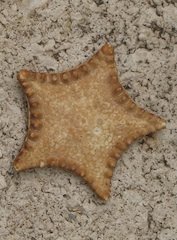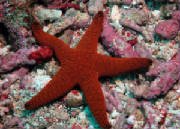
A Starfish Story
A businessman was on vacation, walking along the beach, and saw a young boy.
All along the shore were starfish that had washed up from the tide, and were likely to die in the hot sun.
The boy walked along the shore and reached down here and there to pick up a starfish and toss it back into the ocean.
The businessman, so accustomed to efficiency, walked up to the boy to tell him about his nonsensical ways. ”I’ve noticed what you’ve been doing, son. You have a warm heart and I know you mean well, but there’s so many starfish dying on beaches all over the world. I’m sure you could do something better with your time. Do you really think this is going to make a difference?”
The boy glanced up at the man, and looked down at a starfish by his feet. He picked up the beautiful starfish and tossed it back into the ocean, and said, “It made a difference to that one”.
Adapted from “The Star Thrower” by Loren Eiseley (1907 – 1977)
ECHINODERMS “Spiny-skinned Animals”
Five family members: starfish, brittle stars, sea urchins, sea cucumbers, and sea lilies.
They are found in every sea from below tidal zone to great depths, have 5 divisions to body, radial symmetry, tube feet moved by a water vascular system. Some feet have suction cups. No relatives outside of the ocean. Most have stalked pincers and movable spines.
Sea Stars (Starfish) are the most voracious predators on the ocean floor. Most sea stars can extrude their stomach. A sea star smothers a snail by wrapping its extruded stomach around it or it can pull bivalves apart with its arms. The sun sea star (14 inches wide) is cannibalistic (eating other sea stars.) Sea stars usually have 5 points and an eyespot sensitive to light at the tip of each arm. The sieve (madrepore) is a round spot on the top of the starfish and sieves water going into the water vascular system controlling the tube feet. Sea stars travel on tube feet and some can swim. They cling to rocks or bury themselves in the sand. If a sea star loses an arm it grows back and the lost arm will grow another starfish. Some starfish have no anus. What’s left from food is expelled from their stomach. Mud stars (3-4 inches wide) are a favorite of mine and look like star cookies – almost pentagonal with large marginal plates. They bury themselves in mud beyond the tidal zone.
The reticulated sea star is the largest sea star (12-16 inches) on the Atlantic coast. The central disc is high and divides the surface into triangles.
The sunflower sea star is the largest of the starfish (2 feet across) and may have 21-24 rays. It begins life with 6 rays, grows and sheds arms constantly, and is the worst enemy of the moon snail. Other kinds of sea stars include the long armed snake star, basket star, and blood sea star. Brittle-stars (serpent stars) are fragile secretive animals with long arm plates heavily spined and attached to a central disc.
Sea urchins and sand-dollars may be 2-4 inches across, may have tube feet with sucking disc, usually found in shallow waters, and spines may be short, long, sharp, dull, thick, slender or fluted. They have plates that form a rigid globular or disk-like body covered with moveable spines.
The black sea urchin has spines 12-15 inches long covered with mucous poisonous to the touch and are found in shallow water among rocks and corals from Florida South.
The common sea urchin is found off the Atlantic coast. It decorates itself with debris and shells for protection and is found in low water to 30 feet. The rock boring sea urchin is found off the Atlantic coast in shallow water in mud flats. It is elliptical, 2 inches in diameter with spines ¾ inch long. Sand-dollars have spines and tube feet and may be oval, raised in the center, or round and thin (2-5 inches long/up to 5 inches wide). The cake urchin, cake-dollar, keyhole urchin, and heart urchin are found off the Atlantic coast
Sea-cucumbers live in shallow water, have leathery skin, tube feet scattered or in rows, and radial symmetry. One kind breathes with the tube feet on top and travels with those on the bottom. They are highly changeable in shape with definite front and rear ends. They may be smooth or warty and if roughly handled, may eject their innards. They may be 6-12 inches long and 3-4 inches thick. They eat decaying and small living organisms.. The mouth has branched contractile tentacles.
Sea lilies and Feather Stars are ancient animals. Except for the sea lilies and feather stars, most crinoids are extinct and we know them as fossils. They live in very deep water. Sea lilies are stalked and attached to the sea floor and feather stars are mobile.
Activities: Kids examine a collection of sea stars and look at pictures of sea stars. Create sea stars from clay, or paint them in a watercolor ocean with other sea life and continue the discussion..
Mud Star

Red Star

MADRIPORE

